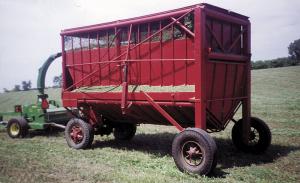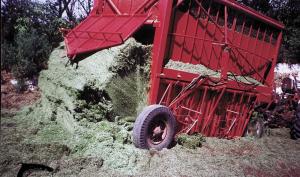2002 - Volume #26, Issue #1, Page #02
[ Sample Stories From This Issue | List of All Stories In This Issue | Print this story
| Read this issue]
Trap Door Forage Wagon Dumps Load On-The-Go
 |
 |
The 8-ft. wide by 16-ft. long wagon rides on four 10.00 by 20 truck tires and has a capacity of 14 tons of haylage. It operates completely on hydraulics, with no belts, chains, or pto gear boxes to maintain. The wagon has a truck axle in front but does not have a rear axle so it straddles the dumped silage.
The wagon has a hinged "trap door" on each side that slopes downward, and an endgate on back that's hinged at the top. Both trapdoors are opened or closed from the tractor by moving a single hydraulic lever. The trap doors are locked together at the bottom by a pair of keys. Moving the lever causes the cylinder to retract and turn the keys one quarter of a turn, which unlocks the doors so they drop open and the haylage falls down onto the ground. As the operator drives forward, the pile automatically pushes the endgate open.
The operator continues forward until the wagon is empty and the endgate drops back down. Then he moves the lever the other way to extend the cylinder and close the trap doors.
"It's a very simple and cheap design with almost no moving parts," says Russ. "I built it last winter and used it last summer to haul 75 loads of haylage. I couldn't believe how well it worked. Every last bit of forage comes out all at once, whereas with an apron chain wagon it takes a long time to unload. I use my International 856 tractor to pull it.
"It works so fast that I have time to spread and pack each load by myself and still get back to the field before the next wagon is filled. A two-man crew, using a small-sized chopper and two of these wagons, can harvest and store at least 50 tons of haylage per hour in a bunker silo. A longer wagon of the same design could be built for commercial use. I'm thinking about building a semi trailer version for big operators that will have a 30-ft. long box. The wagon I built is too wide to be legal for highway transport. The next one I build will be narrower."
According to Russ, speed isn't the rig's only advantage. "There's almost nothing to wear out because hardly anything moves - just the trap doors and endgate, and they open by gravity. All you do is hook up the hitch and two hydraulic hoses. It's safer, too, with no apron chains or beaters. The wagon keeps moving ahead while unloading, so the tractor driver stays away from any possible dust. Another advantage of the bottom-unload design is that I can use it on a slope without worrying that the wagon will tip over."
He screened the sides of the wagon at the top so that air can get out. The roof opens hydraulically. "That's so I can use a loader to fill it with haylage to sell to my neighbors," he notes.
Russ used 6 by 8-in. sq. tubing for the wagon's main frame and 4-in. dia. pipe for secondary framing, then bolted on treated plywood all around.
He has started the patenting process and is looking for a manufacturer.
Contact: FARM SHOW Followup, William E. Russ, 8309 Mitchell Road, Roscoe, Ill. 61073 (ph 815 885-3465; E-mail: JoyceMRuss@aol.com)

Click here to download page story appeared in.

Click here to read entire issue
To read the rest of this story, download this issue below or click here to register with your account number.




